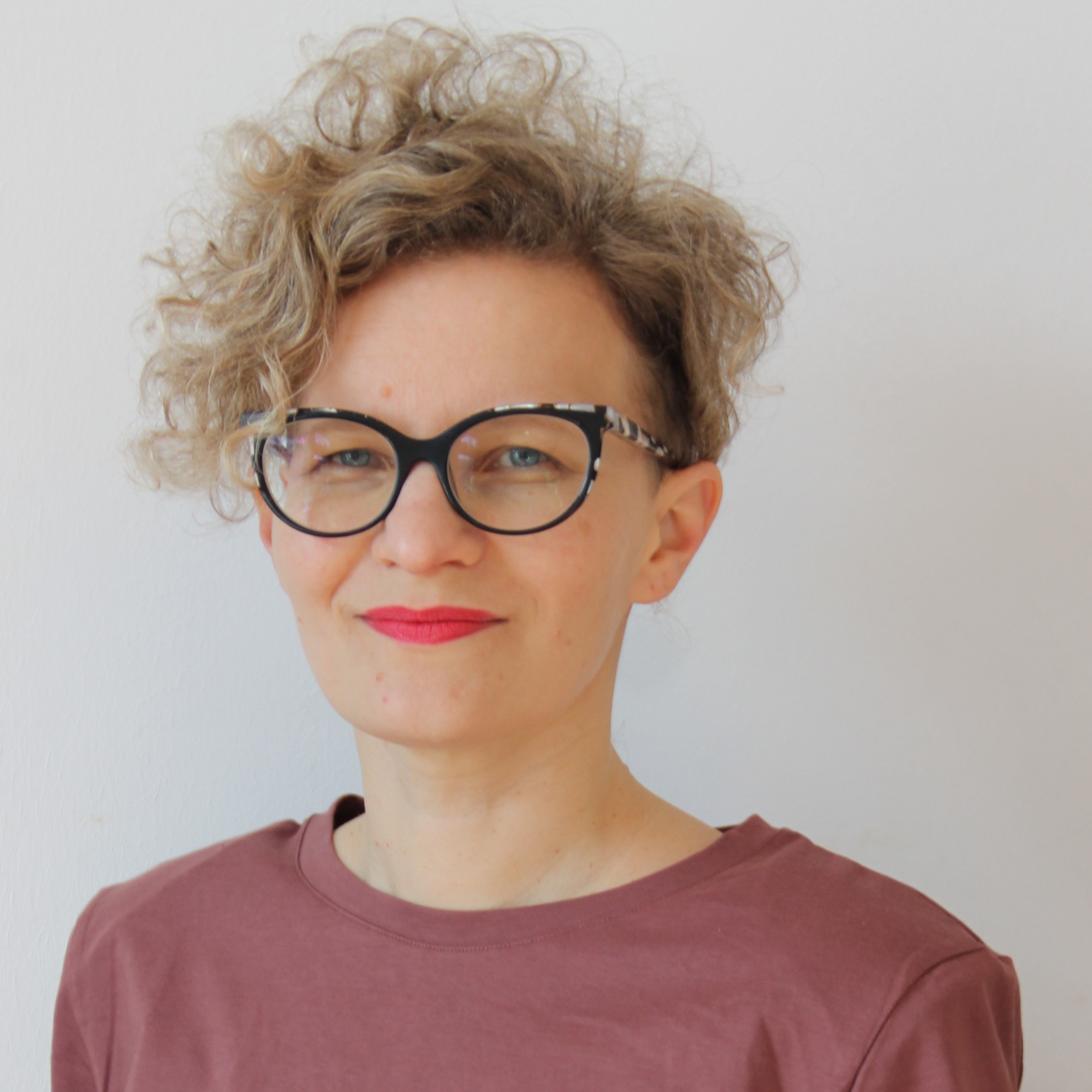About Keys that Don’t Open the Doors, or How to Tell Histories of Soviet Women Artists? Interview with Andra Silapētere
The exhibition I Remember, Therefore I Am. Women Artists’ Archives rethinks marginalized practices realized within a dominantly masculine and heteronormative structures of the Soviet era. Showing at the Latvian National Museum of Art, it focuses on seven women artists whose work has been either nearly forgotten or marginalized: Rita Einberga (1921–1979), Laima Eglīte (1945), Maija Eliase (1924–1991), Mudīte Gaiševska (1935), Ruta Kreica (1946), Rasa Kalniņa-Grīnberga (1936) and Olga Neimane-Kateņeva (1908–2001). Based on archival research, it shows their rich heritage in different media displayed alongside contributions by contemporary artists Anni Puolakka, Marta Trektere, Liliana Piskorska, Evita Goze and Rasa Jansone. In this interview Andra Silapētere shares the challenges of writing their work into art history and underlines the need to revise dominant methods of art history.
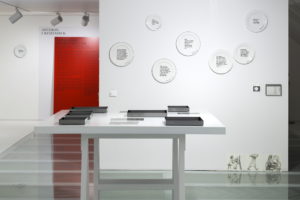
Exhibition view with porcelain plates by Rasa Jansone and Ieva Melgalve. They include quotes from early Soviet Latvian media outlining the rhetoric that women faced. Photograph by Ansis Starks.
Margaret Tali: Research for I Remember, Therefore I Am. Women Artists’ Archives formed a part of an international project in which you participated with a team of 10 researchers. How did you come to work with the project?
Andra Silapētere: About three years ago when critically revisiting our publications and exhibitions at the Latvian Centre for Contemporary Art (LCCA), we realized that we had not paid enough attention to women’s intellectual work and heritage. For instance, we translate important art theories into Latvian, and we noticed that only one woman – Susan Sontag – was included in the list of sixteen publications. That was a turning point and pushed us to consciously give voice to women’s work through our exhibitions and education programs, being a collective of women ourselves. While revising our work, Arton Foundation (Fundacija Arton) in Warsaw invited us to participate in the project “Not Yet Written Stories. Women Artists’ Archives Online”. (For more see, https://lcca.lv/en/events/-not-yet-written-stories—women-artists–archives-online—new-innovative-art-project-to-fill-europ/#izstade). The Photography Center in Zagreb and Contemporary Art Centre in Ljubljana also joined. We are four institutions working separately on this topic and building up a platform, where we will share our research online via the website forgottenheritage.eu .This platform was started several years ago by Arton Foundation in order to give international researchers access to art processes that happened behind the Iron Curtain. But after the first phase of the project, realizing that women have been behind double curtain – firstly being apart from art processes in the Western world, and secondly excluded based on their gender, the “Not Yet Written Stories” was initiated to fill in the gaps.
In each institution the research has been done slightly differently. In Latvia we approached the Art Academy of Latvia and we also held an open call to build a diverse team of people from different disciplines interested in the subject. We worked on this research which lead to the exhibition for a year. Next step will be putting this content online. In September we organize a conference in Warsaw with our partners with a focus on how we can work with histories of women artists’ during the Socialist period. Latvia differs from other partners since it was part of the Soviet Union, while the Poland and Yugoslavia (up to a point) were in the Soviet influence zone [or the Soviet Block]. There are differences in how power worked and we can also see this in art and its development.
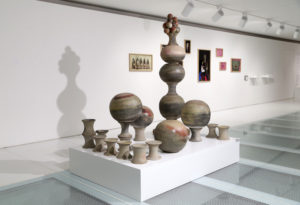
Ceramic forms by Rita Einberga. Photograph by Margarita Ogoļceva.
MT: The exhibition focuses on seven artists from the Soviet era. Why did you choose these particular artists?
AS: Our main material was the archive. We settled on these seven artists based on our teamwork. I wanted to include alternative as well as official artists to understand how they worked within the given frame and how they could find creative languages to express themselves. Most importantly, each artist in the exhibition reflects on our ways of reading history. For instance, Mudīte Gaiševska was a theatre director who participated in the performances of Andris Grīnbergs, an icon of Latvian performance art. While reading her biography and talking to her we found out that she participated in coming up with ideas for Grīnbergs’ performances, which are now in our canon of this period, while she herself is excluded. How should we treat artists who have influenced the canon, but are not represented?
An example is the life story of graphic artists and painter Maija Eliase, who comes from a family of cultural workers – her father was an art historian and uncle a very well-known artist. In this climate of male dominance, she lost her voice. She was painting but didn’t succeed in reaching her uncle’s “level”. Instead she found applied art, working at the “Māksla” [Art] Industrial complex of visual and decorative arts, where she designed different products, etiquettes and murals. As a head of six designers, she travelled realizing many commissions across Soviet-era Latvia. Unfortunately, this part of her work is not appreciated. When talking with her family we understood that the family doesn’t appreciate this work either – they considered it something she did just for money. They even censored half of her archive thinking that painting is the only thing for which she should be celebrated. She has become a hostage to our “tradition” of reading history in which hierarchies exist between media and self-expression – painting is considered more important than decorative arts or design and singular genius is being celebrated instead of collective work.
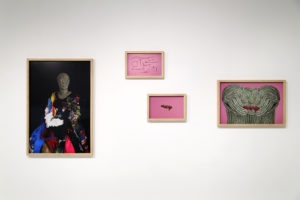
Collages by Liliana Piskorska. Photography by Margarita Ogoļceva.
MT: Maija Elijase’s family’s censoring her archive is a telling example of silencing women’ work. While doing the research did you notice other patterns of marginalizing and forgetting women?
AS: This is not an easy question, because it concerns the way society worked during the Soviet times. Our aim was to represent the complexity of the problems that relate to women’s intellectual heritage, women artist histories or their archives and how we can decode such discriminatory practices. For instance, one of the artists, Laima Eglīte, turned more to her individual life as an artist, woman and wife. This is strongly present in her art. From all seven artists she is the only one who has had a big retrospective at the Latvian National Museum of Art in 2009. The museum has acquired an impressive collection of her works, but they are excluded from their collection display. While the permanent collection engages with broader problems and common narratives and such an intimate woman’s world wasn’t seen as relevant, even though the curator of the permanent collection is a woman.
Some patterns of forgetting are summed up in the essay by Ieva Melgalve and Adele Bea Cipste “Soviet Latvian Women Artists in Periodicals. Eight Ways of Forgetting”. (I Remember, Therefore I Am. Unwritten Stories: Women Artists’ Archives, Exhibition Catalogue. Latvian Centre for Contemporary Art; Latvian National Museum of Art, 2020. The catalogue was published in the form of a folder that the exhibition visitor could compile of different materials themselves.) One of the patterns they note is women’s social role as a mother and a teacher which often obscure individual accomplishments. An example is Rita Einberga (1921-1979), a ceramic artist who made brilliant work throughout the 1960s-70s. She was an outstanding teacher and her ideas were taken over by her students. The absurdity is that now we see her students’ work, while we are not interested in the sources of their ideas. One of the masters in local art history Peteris Martinsons, who changed the language of ceramics at the time, was her student. Einberga gave him her techniques and working methods. Going through the catalogues of their work there are many copy-paste moments. As a teacher Einberga has been forgotten and this is related to the kinds of roles women are given.
During the Soviet time a popular photographic competition called
Our Woman was organized every year, but throughout decades not once a female photographer won. I had an interesting conversation with photographer Mara Brašmane, who started her career in 1960s and 70s. She talked about how the male gaze plays a role in defining things and in assigning importance. She told me how this same male gaze that excluded her, sometimes also shaped her perception of the times she documents in her photography. While acknowledging it as a problem, she has created works with a more varied interpretation of the times, that is lacking in the work of her male colleagues.
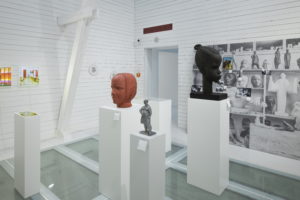
Exhibition view . Photograph by Ansis Starks.
MT: In 2019 Ingrid Ruudi curated A Room of One’s Own. Feminist’s Questions to Architecture, which dealt with Soviet structures of recognition in architecture. Ruudi’s research of the gender makeup of the deciding committees and gender balance of awards found that since awards were given out by men, women’s chances of getting them were practically non-existent. Do you see any parallels in the Latvian art field?
AS: Our exhibition deals with this question through the act of remembering and forgetting of women’s history. Remembering is here representing tolerance, solidarity and a wish to acknowledge different histories that can open bigger narratives. I came to remembering by reading the autobiography of Mudīte Gaiševska, where she attempts to remember her personal and professional life. Paraphrasing Descartes’ famous saying, she writes
I remember, therefore I am”. These are the first steps: remembering and writing it down, but through this she also allows to preserve her history. She does it knowing that she has been excluded. It was important for me to realize that she understands that she will almost definitely be forgotten if she doesn’t write this history down herself. Not only because memory is fading [Gaiševska is 85 years old], but also because she realized that other people will be celebrated for the work that she did. It is tragic.
For us, the crucial question was how can we bring these stories back. Why are we forgetting? This doesn’t concern women’s histories alone, but also different cultures, nationalities and backgrounds. Olga Neimane-Kateņeva in out exhibition had an incredible life story. She was born in India to a Russian father and a Latvian mother. She expressed her heritage in her porcelain work by including Asian and Slavic motives. Even though contemporary collectors pay crazy amounts for her work, she is missing from our cultural history and these cultural influences might not support it. Her work illuminates the complicated and tragic history of the Soviet occupation that after the independence led to a nationalistic wave and excluding of other cultural influences from “our” narrative of history and marginalizing difference.

Material from the archive of Ruta Kreica. Photograph by Ansis Starks.
MT: You write in the catalogue that you aim to “give these artists their voices back”. This seems to be something which is increasingly claimed in the art world, but in fact very difficult to realize. How exactly did you work with restoring the artists’ voices?
AS: We worked with material that was fragile and not always accessible. For instance, with Rita Einberga, there is no real evidence of her voice anymore. There is one interview published with her, even though she was a recognized artist during her lifetime. She lived alone and didn’t have children who could have inherited her archive. Actually, her archive burned down, so there is almost no material to work with. In putting the puzzle together, we talked with her contemporaries, worked with different institutions who had evidence. Her story is still very fragmented, and it’s a story that asks for a continuation. There is a tragicomic story also with Mudīte Gaiševska’s archive. She now lives in England with her son, but most of her archive is here in Latvia. We met several of her contemporaries to ask about her work, but in these meetings they were in fact telling their own stories. Since most of them were men, they managed to exclude her even while talking about her… (laughs) Even if you have a wish to restore stories, sometimes it is the physical barriers that get on the way. Gaiševska’s son sent us the key to the flat where the archive is supposed to be in Riga. But the key didn’t work… (both laugh). Of course it is funny now, but this talks about the material too.
MT: It’s a kind of metaphor – there is a key, but it doesn’t open the door!
AS: Exactly! It tells about the barriers, their building and solidifying over time.

Exhibition view with paintings by Laima Eglīte. Photograph by Margarita Ogoļceva.
MT: You worked with historical material, deciding to mix it with contemporary art. Why did you choose this curatorial approach?
AS: We brought in contemporary artists because their reactions to this material and thinking about history writing can be very inspiring for bringing in new questions. They helped us to realize that if we don’t have evidence and a gap has to be filled, then making the exhibition allows for some speculation based on the archive. For instance, Polish artist Liliana Piskorska has researched lesbian histories in Poland to build up a narrative about histories which have been forgotten and are still being forgotten because of far-right political agendas. She tells a history that has never been told and builds up metaphors. In her film “Strong Sister told Brothers” (2019) she is translating a well-known Western queer manifest into Polish.
I was also glad to work with the artist duo consisting of Finnish artist Anni Puolakka and Latvian artist Marta Trektere, who have collaborated since 2018. Their work is built on friendship and common interests in love, music, images and sex. They change roles – curating each other’s work, being each other’s assistants – to create hybrid ways of being that disrupt disrupting established norms. Their work is about creativity, hybridity and support that they give each other in a way that proposes a different existence.
The project was a collective work of making marginalization of women relevant to a broader audience. One thing we tried to tackle, but were not able to mediate clearly enough was the complexity of the Soviet period and how change of power brought along changes in art. It was messy. In Latvia this period’s art history still has not been written, but at the same time we have this history written through the museum collections, which in a sense present official history too. We tried to tell this history through artists, who represent both official and unofficial scenes and rethink this historical period through their work.
MT: Thank you, Andra!

